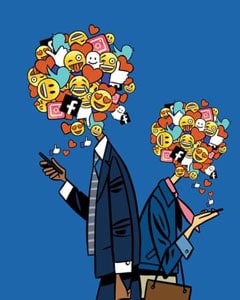
Is there a Loneliness Epidemic

Loneliness is part of the human condition. It has many variants and take on a unique shape per individual and their environment. It is harmful to both our physical and mental health, as well as being a deeply painful experience. So is it true that loneliness has reached epidemic levels?
That’s what some health officials are saying, but what does the data say? We look into what’s known (and not known) about the prevalence and effects of loneliness.
Defining Loneliness
For the sake of clarity it’s worth understanding the differences between isolation and loneliness. They are conceptually quite different.
“The way they are conceptualized and measured is quite different,” says Julianne Holt-Lunstad, a psychology professor at Brigham Young University. Holt-Lunstad was the first U.S. researcher to publish a large-scale analysis of studies establishing poor social support as a major contributor to morbidity.
Isolation is defined more by the actual size of one’s network or the frequency of contact, she says, whereas loneliness “is thought to be more of a subjective experience or perception of isolation, a discrepancy between one’s desired and actual level of connection.”
Further, she observes: “Someone can be lonely but not isolated, or isolated but not lonely.”
Given how subjective loneliness is, what are some broader themes that affect our loneliness and how has it changed throughout history?
SOME CUASES OF THE LONELINESS EPIDEMIC
Time brings change and much has changed from two thousand years ago where humans lived in tribes for survival. One thing that will however never change, regardless of our environments, is the fact that humans are social creatures.
Since ancient times, millions of people have died of epidemics of plague, flu, cholera, and other infections caused by bacteria, viruses, or other microorganisms. Major advances in medicine have largely eliminated these mass killers with vaccines and antibiotics.
However, modern societies are facing a new kind of epidemics: behavioural epidemics.
The annual rates of mortality by suicides and opioid overdose have been escalating over the last 2 decades and today are responsible for the death of 1 American every 5.5 minutes. Consequently, the average US life span, which had been rising progressively since mid-1950s, has fallen for the first time.
Contemporary Society
One of the largest contributing factors of the “loneliness epidemic” is the changes in contemporary society. This pertains to our social behaviours, living circumstances as well as how technology and automation have changed our lives.

Changes in contemporary society have made it even more difficult for us to build meaningful relationships. We increasingly work from home. Fewer of us are members of professional associations. In many countries, unemployment is on the rise. Most problematic, organisations, where paranoia prevails, are becoming the norm.
In our personal lives, more people than ever before live alone, either because they have chosen to delay marriage, have divorced or had altogether given up on forming a stable partnership. Even people in a relationship often suffer from a lack of intimacy. Nothing can be lonelier than being in a relationship with an emotionally distant person.
Furthermore, communities are no longer what they used to be. In big cities, it has become easier to ignore the others around us. As we order food and all sorts of goods online, there’s not even a need to talk to a cashier. Recent years have seen the rise of self-service checkout lines along with a multitude of automated systems. All eliminating human interaction.
Automation and Technological Advancements
Technology has brought us an incredible amount of benefits, including the automation of many time consuming elements of our daily lives. We no longer have to stand in long lines to deposit or get cash out at the bank. We don’t even have to stand in lines do our grocery checkout. Unfortunately it comes at the cost of human interaction.
I like the analogy by Talking Heads lead singer, David Byrne that we can think of small social interactions as small puffs of air in a deflating tire. We need little bits every day to keep going.
Beyond the deep and meaningful connections we need to thrive, we evidently also need small every day interactions with other people. All of these interactions are now being eliminated by the machine.
The inventor of the ATM and the Talking Heads singer David Byrne join Dr Laurie Santos to explore the ways in which talking to strangers can bring us all genuine joy. Listen to this poignant episode below, I would highly recommend coming back and listening to it.
Another interesting thing to consider is that most engineers/designers/inventors are stereotypically introverts, who don’t particularly need or crave human interaction as much as others.
Even though all these technological inventions are built on good intentions to make out lives easier, we are inadvertently living the inventor’s lives – which is often lives with less human interaction.
Social Media and The Loneliness Epidemic
All too often, we turn smart phones, tablets and computers into pseudo-defence systems to help us cope with our loneliness. These devices have become the ideal crutches to lean on, especially when we feel anxious.
Constantly looking at our phone and multiplying attention-seeking social media postings show our desire to be needed by others.
Even though social media enables us to stay in contact with more ease and from all ends of the earth, it has ironically destroyed our social skills. There is absolutely no substitute for physical human interaction. It is part of our DNA to interact with other humans on a physical level.
That doesn’t mean physical in the sense that you need to touch another person, but being in the physical precedes of another person. Our minds are complex devices that pick up on so many nuanced things that we only get in person. The authenticity that hence stems from physical interaction is much deeper.

Feeling connected to others in a meaningful way – not through screens – can be considered a fundamental human need. It is crucial to both our wellbeing and survival. Unfortunately, such connection has become increasingly hard to find
As we saw earlier, loneliness is subjective, a discrepancy between one’s desired and actual level of connection.
The thing with social media is that the perspective is completely skewed. Leaning on social media when we feel anxious only exasperates the issue. No one posts photos or videos of them being lonely.
All you see on social media is people having fun, doing things – having the best connections. This is very likely to alter your perception of your own connections, or lack there of.
It is essential that we remember that social media is not a true representation of the human experience.
So perhaps we need to stop using social media as a crutch and as our main method of interaction. Perhaps we should use it as a tool that facilitates physical interaction. Use it not only speak to our friends, but use it to organise a physical catch up so we can interact in person.
THE EFFECT OF CHRONIC LONELINESS: STATISTICS
It is important to grasp the very real consequences loneliness has on our health and society.
Health risks
- Loneliness, living alone and poor social connections are as bad for your health as smoking 15 cigarettes a day. (Holt-Lunstad, 2010)
- Loneliness is worse for you than obesity. (Holt-Lunstad, 2010)
- Lonely people are more likely to suffer from dementia, heart disease and depression. (Valtorta et al, 2016) (James et al, 2011) (Cacioppo et al, 2006)
- Loneliness is likely to increase your risk of death by 29% (Holt-Lunstad, 2015)
Loneliness and older people
- The number of over-50s experiencing loneliness is set to reach two million by 2025/6. This compares to around 1.4 million in 2016/7 – a 49% increase in 10 years (Age UK 2018, All The Lonely People)
- There are 1.2 million chronically lonely older people in the UK (Age UK 2016, No-one should have no one).
- Half a million older people go at least five or six days a week without seeing or speaking to anyone at all (Age UK 2016, No-one should have no one).
- Over half (51%) of all people aged 75 and over live alone (Office for National Statistics 2010. General Lifestyle Survey 2008).
- Two fifths all older people (about 3.9 million) say the television is their main company (Age, U.K., 2014. Evidence Review: Loneliness in Later Life. London: Age UK).
- There are over 2.2 million people aged 75 and over living alone in Great Britain, an increase of almost a quarter (24%) over the past 20 years (ONS).
Loneliness and people of all ages
- A study by The Co-op and the British Red Cross reveals over 9 million people in the UK across all adult ages – more than the population of London – are either always or often lonely.
- Research commissioned by Eden Project initiative The Big Lunch found that disconnected communities could be costing the UK economy £32 billion every year.
Loneliness and families
- A survey by Action for Children found that 43% of 17 – 25 year-olds who used their service had experienced problems with loneliness, and that of this same group less than half said they felt loved.
- Action for Children has also reported 24% of parents surveyed said they were always or often lonely.
Loneliness and disabled people
- Research by Sense has shown that up to 50% of disabled people will be lonely on any given day.
LONELINESS EPIDEMIC 2020

We are currently living in unprecedented times with the COVID-19 Pandemic demanding social distancing, quarantine and isolation.
Collectively, we understand the goodness of “flattening the curve” so that vulnerable individuals are not exposed to the virus and healthcare systems are not overwhelmed. Each of us must do our part to slow the spread of the virus.
But it is not the only epidemic we are facing right now.
The requirement to separate ourselves from others comes at a time when many other nations are in the midst of an epidemic of loneliness whose antidote is greater positive social connection.
Our current situation—the simultaneous need to reduce physical distance and to increase social, or relational, connection to curb the rise in loneliness—presents a challenge for us all. Ignoring the need for connection at this time is not an option.
Research suggests that the majority of individuals today lack sufficient social connection. This connection deficit may exacerbate the negative effects of stress and diminish physical and emotional resilience that people will need to fight the COVID-19 virus.
Relational connection is especially important during the COVID-19 pandemic. Fortunately, there are steps people can take to boost social connection while maintaining physical distance.
Individuals can still experience the physical and emotional health benefits that arise from sufficient meaningful connection, which will help them fare better through this difficult time.
HOW TO FIGHT THE LONELINESS EPIDEMIC
It’s important to understand that connection is essential because the lack of sufficient connection has a wide-ranging impact on our bodies, including increasing the negative effects of stress and diminishing resilience.
Here are practical actions you can take:
1. Cultivate a connection mindset. Boosting connection begins with adopting a mindset that connection is desirable and necessary. To help cultivate this mindset among the people you interact with, share this article with individuals in your social networks.
2. Take care of yourself. You can’t give what you don’t have. To be a good connector with others, we need to make sure we are physically and emotionally strong and steady. We do this by making sure we are connecting with people who energise us.
Be sure to get adequate sleep and exercise (check out exercise videos on YouTube), and eat healthy. When we are stressed or lonely, these practices often get pushed aside. (Why make a salad when the potato chips are so handy?)
3. Pause to be grateful. Every day, take a few minutes to write down at least three things you are grateful for. Gratitude helps keep you emotionally strong and will help you connect better with others.
4. Serve others. Reaching out to help others in need boosts neurochemicals that produce positive emotions. In the current climate of encouraging physical separation, this may include writing a card or letter to an isolated elderly parent, relative or friend, or calling to find out how he or she is doing.
5. Do the small things. Make eye contact when you walk past someone. Smile at someone. Say “Hi” to strangers you sit next to on the train. Talking to strangers even for 30 seconds has been proven to cause a boost of serotonin on both ends of the conversations.
6. Talk about it. Loneliness is not a bad thing, it is a biological cue, like being hungry, for us to take action and do something that our bodies need. Break the stigma around loneliness and talk about it.
CONCLUSION
The word ‘epidemic’ suggests that things are getting much worse and loneliness is increasing rapidly. But does the data in fact show that societies are becoming lonelier?
An article by The Economist points out that loneliness certainly deserves attention, but that historical data about loneliness are still scant which makes it, therefore, difficult to declare it a global epidemic. Though evidence suggests that isolation does seem to be increasing, so loneliness may be too.
What we do know is the very real effects chronic loneliness has on us and that the numbers are certainly increasing. The research and science will certainly start adding up in the near future to hopefully draw more attention to this social issue we are facing.
Loneliness is a behavioural epidemic that our modern societies are facing and will continue to face until we break the stigma around it. The more we talk about it the more we can address this public health issue.
Below is another fantastic Podcast episode if you would like more in depth conversations on the topic.
Have you felt the effects of loneliness in your life? Join the conversation in the comments section below and let’s talk about it.
You May Also Like

8 New Years Resolutions for INFJs
January 1, 2020
Dealing with grief as an Introvert
January 17, 2020


